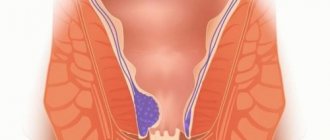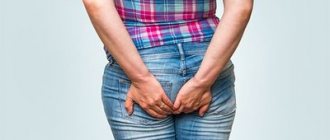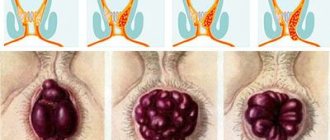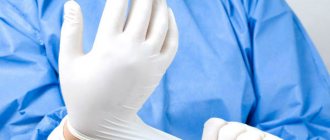Hemorrhoids are a fairly common disease among middle-aged people, including women. Due to the fact that a rather delicate area of the female body is affected, many ladies are embarrassed to come to the clinic for help with this disease, and quietly suffer from painful manifestations. Often, many women are confident, or at least hope, that the disease will go away on its own, although this happens extremely rarely. What is the cause of this insidious disease, and what are the first signs of hemorrhoids in women? We will try to find the answer to these and other questions in this article.
Types of hemorrhoids
The pathological condition of the rectum in women and men can be expressed in the following forms:
- external;
- internal;
- combined.
If nodes and seals are visible to the naked eye, then we are talking about external hemorrhoids. In the case when hemorrhoidal cones are beyond the reach of a person’s vision, inside the rectum, then this type of disease can safely be called internal. If there are formations of dense tissue both inside and outside, then this is a combined type. Let us dwell in more detail on internal hemorrhoids.
Treatment of hemorrhoids during pregnancy
In most cases, the pathology is treated conservatively. The expectant mother's diet should include vegetables and fruits. She should exclude salty, spicy, and pickled foods from her diet.
When asked how to treat hemorrhoids in women, doctors answer that they use medications that do not negatively affect the fetus. The choice of drug depends on its severity and severity of clinical manifestations. Local remedies are used - rectal suppositories, ointments with an analgesic effect. Phlebotropic drugs and anticoagulants are indicated for a pregnant woman.
Internal hemorrhoids
Internal hemorrhoids: symptoms in the initial stages are difficult for the patient to determine. There are no visible manifestations of this disease, and painful sensations can be attributed to other diseases or general malaise. The early period of the disease is not characterized by bleeding or prolapse of hemorrhoids. A slight discomfort during defecation, a slight burning sensation in the anus in the rhythm of constant time pressure can simply not be noticed or not given due importance. Of course, when the disease begins to progress, the symptoms also change. Nodes of enlarged hemorrhoidal veins do not allow stool to pass painlessly through the rectum. They squeeze it, narrowing the passage and making each bowel movement painful, and sometimes even excruciating. Itching and burning intensify; this can be facilitated by mucous discharge that accompanies the disease in more advanced stages. A person feels a terribly unpleasant odor when defecating, and underwear can also have a characteristic amber. This can lead anyone into a state of panic, especially women. In addition to the smell, mucous discharge irritates the anal area and can lead to inflammatory processes in this place. Any slightest movement can cause unbearable pain in a person; the feeling of discomfort does not go away either in movement or at rest. It always seems to a person that there is something foreign in the anus. This sensation is caused by swelling of the rectum and an increase in the size of the hemorrhoids. Both women and men may have blood in their stool during bowel movements. Representatives of the fairer sex may not attach much importance to this if such a phenomenon occurs during the period when women are menstruating. Bloody discharge may at first appear only as small specks in the stool, and then, as the disease progresses, even trickle down the toilet and leave marks on the underwear. Bowel movements may be accompanied by severe pain, and there are frequent cases of hemorrhoidal cones falling out. At first, a person can straighten these seals into the inside of the rectum himself, but a moment may come when only doctors can do this. Another symptom of internal hemorrhoids is the formation of cracks. As the cones grow, the rectal mucosa cannot stand it and bursts, leading to the appearance of cracked fragments. This is an additional source of pain, from which it is difficult to protect both women and men.
How to deal with hemorrhoids?
Anuzol suppositories are especially effective in cases of heavy bleeding due to hemorrhoids
The manifestation of all the above symptoms signals the patient to immediately contact a medical institution for help. The sooner this happens, the shorter the treatment will be and the faster the recovery will come. In the treatment of hemorrhoids, it is important to follow a special, proper diet that normalizes the activity of the entire digestive tract and promotes a speedy recovery. The patient's diet should not contain spicy foods, saltiness or spicy dishes. Smoked foods, fatty foods and anything fried should be avoided. Alcohol is also contraindicated for hemorrhoids. Compliance with this diet will help reduce the likelihood of the patient developing new hemorrhoids and prevent further growth of existing ones.
When fighting hemorrhoids and its manifestations, a woman should be more careful about observing personal hygiene requirements. It is advisable, when this pathology progresses in the patient’s body, to use wet wipes after defecation, so as not to further injure the inflamed skin around the anus and not to irritate its mucous membrane. When treating hemorrhoids, you should follow all recommendations and instructions of your doctor. By observing all of the above, you can overcome even the advanced stage of hemorrhoids.
Features of internal hemorrhoids in women
Hemorrhoids can be called a “bisexual” disease, equally likely to affect both women and men. But the physiological characteristics of women can become a factor leading to hemorrhoids. This disease can manifest itself in the fairer sex for a number of reasons:
- Features of physiology. During menstruation, the vessels of the pelvic organs are filled with blood and this is an unfavorable moment for the appearance of hemorrhoids.
- Some gynecological diseases.
- Passion for diets. It's no secret that figure is very important for women. Throwing yourself into the loophole of certain dietary restrictions can lead to chronic constipation, which can negatively affect the condition of the rectum.
- Pregnancy. At this time, women’s motor activity decreases, the load on the entire body and on the vessels in the pelvic area also increases. Pregnant women often suffer from constipation. The enlarged uterus compresses the pelvic vessels.
- Childbirth. There is even a special term - postpartum hemorrhoids. During the birth of the baby, cracks may occur when pushing. Lumps in the anus and rectum.
Is it possible to cure chronic hemorrhoids with folk remedies?
Unfortunately, chronic hemorrhoids cannot be cured using conservative methods. “Folk” methods give a short-term effect. Similar results will be obtained with “home” drug treatment.
The unpleasant symptoms of the disease may disappear for a while, but the disease will develop unnoticed by you. In the future, the following complications may develop: • anal fissure; • anemia; • nervous exhaustion; • infectious processes (proctitis, paraproctitis, etc.).
It should also be noted that under the mask of hemorrhoids a deadly disease such as rectal cancer . Therefore, if alarming symptoms appear, you should urgently consult a doctor to find out an accurate diagnosis and begin adequate treatment.
Don’t waste time on self-medication, come to an appointment with a proctologist!
Possible complications
Due to the fact that internal hemorrhoids are much more difficult to diagnose than external hemorrhoids, you can skip the period of possible effective treatment. The effectiveness of all procedures aimed at combating the disease depends on the period in which the patient sought help at the hospital. It is very important for both women and men to pay great attention to their health and undergo regular, complete examinations whenever possible. If, nevertheless, the onset of the disease is missed, then this can lead to such troubles as anemia, strangulation of the node and the occurrence of thrombosis. Anemia occurs due to the fact that a person begins to lose blood with each bowel movement, and with each subsequent time more and more. A lack of hemoglobin will result in weakness, rapid fatigue, and a constant desire to lie down and rest. Thrombosis of hemorrhoids is formed due to the fact that blood stagnates in the area of the body responsible for emptying. Severe pain is the main characteristic of this problem. If inflammation is added to this, then you may encounter an even greater problem - damage to the perirectal tissue.
Causes
The main reason for the development of internal forms of hemorrhoids is a violation of the inflow and outflow of blood in the cavernous (cavernous) bodies. In a healthy person, these corpuscles fill with blood when the intestines are filled with feces, which causes them to increase and makes it easier to control the urge to defecate. After successful bowel movement, blood flows out and the cavernous bodies shrink.
If the regulation of outflow is disrupted and the cavernous bodies are constantly in an increased size, then over time this leads to varicose veins and thinning of the venous vessels. The main causes of blood outflow disorders traditionally include the following factors:
Timely diagnosis
To avoid hemorrhoids and possible complications, it is necessary to identify the disease at its earliest stages. Internal hemorrhoids can be detected by digital examination of the rectum, feeling for compaction of the hemorrhoidal veins. But such an examination is effective only when the nodes are located low. If the cones are located high up, then only modern equipment can help in diagnosing the disease. Anoscopy and sigmoidoscopy are the most common techniques. In the first case, a special tube with an optical device is used, which allows one to examine the rectal mucosa over a ten-centimeter length. If the hemorrhoids are located even higher, then you cannot do without the help of a sigmoidoscope. The rectum at a distance of 25 cm will be “in full view” to the doctor. If the patient states that during defecation he himself observed the prolapse of nodes, then a diagnosis can be made based on this reliable fact. True, unfortunately, for the patient the stage of the disease in this case is later, and therefore less treatable.
Radical treatment of pathology
Minimally invasive methods
Doctors treat chronic hemorrhoids with surgical methods. At the initial stages of the disease, preference is given to minimally invasive techniques, which are carried out on an outpatient basis (without placing the patient in a hospital) and provide for a short rehabilitation period.
An important advantage of low-traumatic operations is a short list of contraindications. The list of methods that are suitable for most patients includes: • sclerotherapy (injection into dilated veins of substances that cause “soldering” of the walls of dilated veins); • infrared coagulation (cauterization of the leg of the node); • ligation of the internal hemorrhoid with latex rings.
Sclerotherapy and infrared coagulation are used at stages I – II of the development of internal hemorrhoids. The effectiveness of these methods at stage I is 85%, and at stage II – about 72%. If the node is ligated with latex rings, the effectiveness exceeds 93%.
Operation hemorrhoidectomy
Hemorrhoidectomy is the removal of enlarged hemorrhoids using surgical methods, that is, using a scalpel.
Such treatment must be carried out in a hospital. The rehabilitation period is much longer and is less well tolerated by patients. Therefore, surgical removal of nodes is carried out only in the last stages of the disease , when minimally invasive techniques are no longer effective.
Hemorrhoidectomy can be combined with disarterization of hemorrhoids under ultrasound control. This method is often used for stage III internal hemorrhoids.
The choice of surgical intervention method depends on the number of enlarged nodes, their location, as well as the presence of complications and concomitant pathologies.
Conclusion
I would like to draw a conclusion from all of the above - you should not delay going to the doctor if you notice at least one of the signs of internal hemorrhoids:
- itching;
- burning;
- pain during bowel movements;
- appearance of blood in the stool;
- mucous, odorous discharge;
- prolapse of hemorrhoidal cones.
If you find such signs in yourself, do not panic, but pull yourself together and find a good proctologist. Hemorrhoids can be treated successfully if all medical instructions are followed. You should not discount traditional methods (as an addition to the main treatment) or lifestyle changes. Start eating right, sign up for a fitness center, give up bad habits - success will definitely be on your side!
Stages of development of chronic pathology
In chronic forms, in addition to the admixture of scarlet blood, itching in the anus is disturbing.
Depending on the degree of dilation of the veins, there are:
- Stage I – the node is located in the intestinal cavity.
- Stage II - loss of the node occurs during straining, then the node is reset on its own.
- Stage III – the patient independently reduces the node.
- Stage IV – it is impossible to set the nodes, they are located outside.
Regardless of the stage, hemorrhoids can be complicated by thrombosis, which will manifest as unbearable pain.
If treatment is not done in a timely manner, a number of complications are possible, ranging from anemia to neurological disorders.
Clinical prognosis
The overall clinical prognosis is always favorable. Modern proctological methods make it possible to successfully treat internal hemorrhoids even at the most advanced stages.
The disease can pose a threat to life only if the hemorrhoids become necrotized with the addition of blood poisoning, but this is only possible in the case of a long, persistent and conscious refusal of the patient to receive medical care.
Surgeon-coloproctologist, surgeon of the highest category. Rakhmatullin Andrey Albertovich









